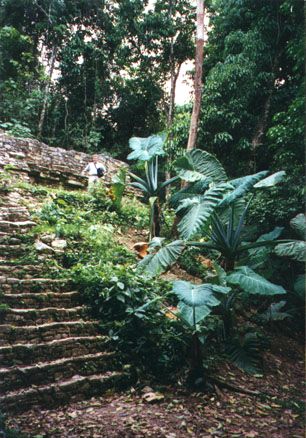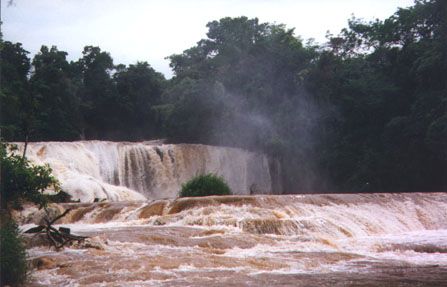17 APRIL (Thursday)
In the morning we returned to the ruins of Palenque, completing our explorations there by
midday. In the morning hours there is a fog that hangs over the trees on the nearby trees
that makes the site seem very ancient and mystical. I also found a path (that led to the
Temple of the Cross group by a roundabout way) that I really liked, as it was
roughly-hewn, not well-traveled, and the surrounding jungle seemed to be working on
swallowing it up. It imparted that "Indiana Jones" flavor that was such a
contrast to the sites that were near Cancun. Climbing the path, you have to watch your
head from low-hanging branches, watch your feet for tangling roots and obstacles, and keep
an eye out to stay on the wandering path so that you don't accidentally find yourself lost
in the rain forest. Along the way you come across the ruins of a temple that has not been
restored and was not listed on my map. I wouldn't be surprised if they've paved it through
by now, but when we were there, it was wonderful.

Here I am at the ruins mentioned in the previous paragraph. (I'm on the upper level
with light-colored clothes and a black camcorder case.) This is ruins exploring at it's
best - no tourists, and no signs of modern civilization. You can easily imagine yourself
alongside Stephens and Catherwood discovering the ruins for the first time in the 1840's.
The jungle is constantly trying to cover these unreconstructed sections of Palenque.
After we finished the site, we stopped at the little shops outside the admissions gate,
where vendors sold a variety of goods for the tourists. The white-robed Lacandon Mayan
Indians are there, selling bow and arrow sets in various sizes. These sets are modeled
after the ones that they have used for centuries, but they are obviously ornamentive sets
for the tourists instead of functional pieces. Each set has eight or so arrows arrayed in
a fan, set against the backdrop of a drawn bow. Each stone arrowhead is of a different
shape (one for wild pigs, one for fishing, one for large game, one for birds, etc.). They
are reasonable in price, roll up into a shape you can take on the plane home, and make
interesting wall decorations/conversation pieces. I bought a small set as a gift, and a
larger one for myself.
We then proceeded to the new museum at Palenque, which displays a variety of artifacts
that were rescued/liberated from the site. It is common for Mayan archeological sites to
have an official museum nearby, where delicate pottery, statues, and artwork from the site
can be displayed, while being protected from the ravages of weather and tourists.
After a lunch at the restaurant of a hotel that wasn't too far from the museum, we hit
the road and drove to the waterfalls at Agua Azul. There were a fair amount of people
there, but most seemed to be Mexican rather than tourists. There are a series of
waterfalls at Agua Azul (though the agua is not azule, it is more like a dirty brown), and
while there are some relatively calm spots in the river, it is not real safe to swim
there. There is a monument or marker near the water's edge where one or more people
drowned as a constant reminder of that. After climbing around the area's paths for awhile,
we finished taking our photos and went back to the car. We briefly considered continuing
down the road to the waterfall at Misol-Ha, but by this time we were tired, and figured
that we would just head back to the hotel rather than take a chance on getting caught out
on unknown roads after dark. If you go to Palenque, consider side trips to Bonampak,
Yaxchilan, Agua Azul, Misol-Ha, and the Mayan ruins of Tonina (outside of Ocisingo). As
long as you're in the area, you might as well see all that you can.

The brown water at the waterfalls of Agua Azul (translation: Blue Water). Note the
mist drifting towards the trees in the center of the photo.
We got back to the hotel in time to avoid a late afternoon downpour of rain. We watched
from the windows of our room as the cows in the yard next door continued their grazing
despite the heavy rain. The rain soon let up, then stopped. We realized how fortunate we
were to have spent two weeks in this part of the world without having any of our
archeological explorations dampened by rain. The only rain that we encountered was always
during our "off-duty" hours.
We finished the day with another good dinner at the hotel restaurant. The meals were
generally so much cheaper on our trip that we could easily afford the higher-priced
selections (like steak), and we took advantage of that on numerous occasions.